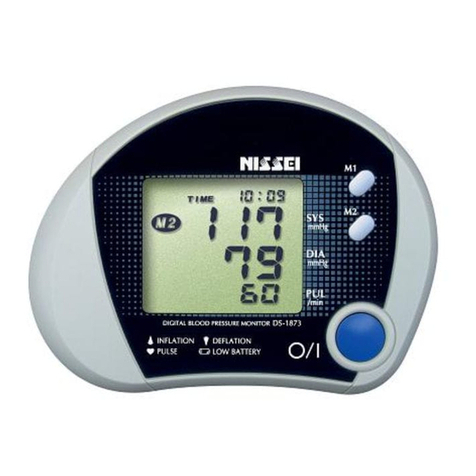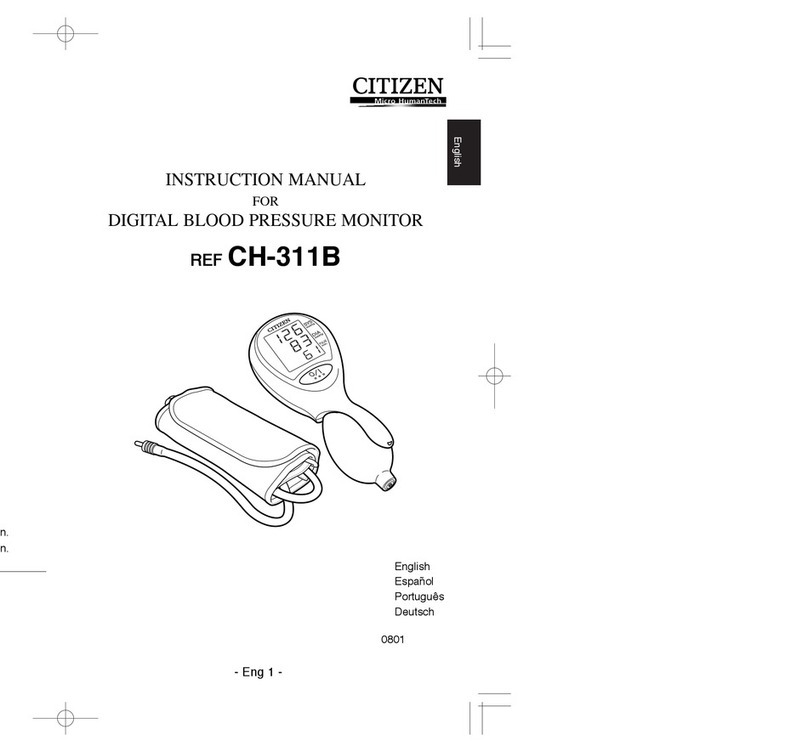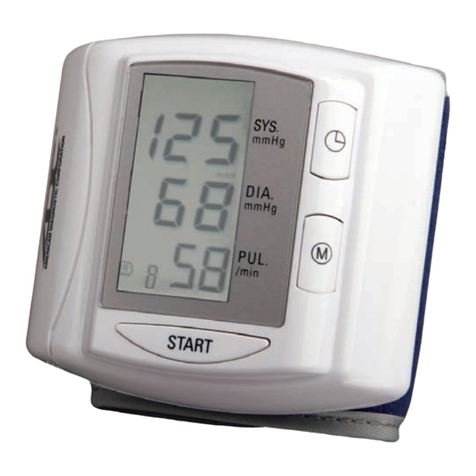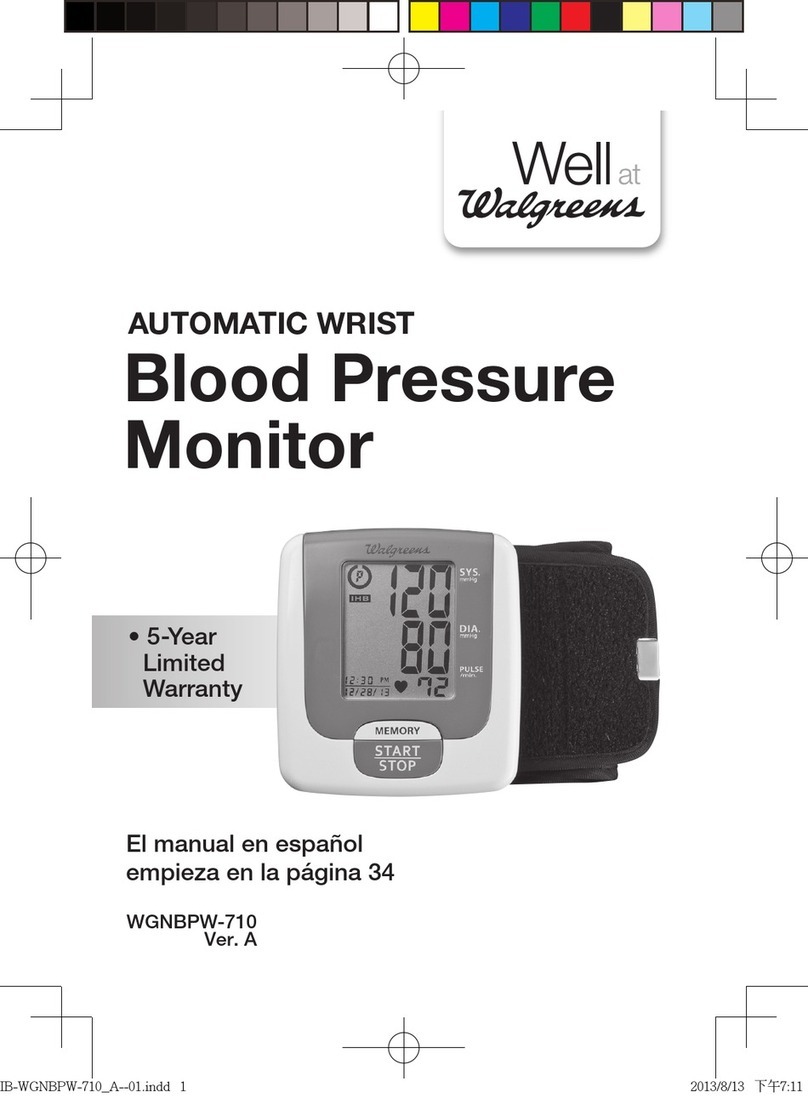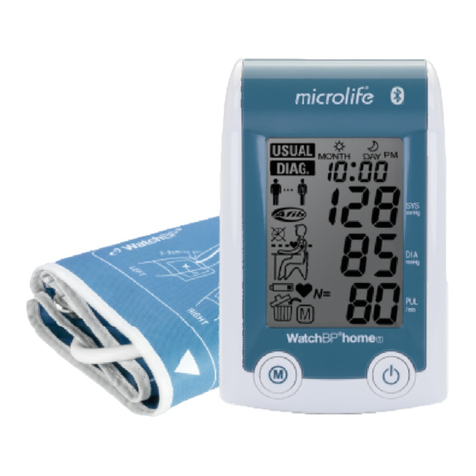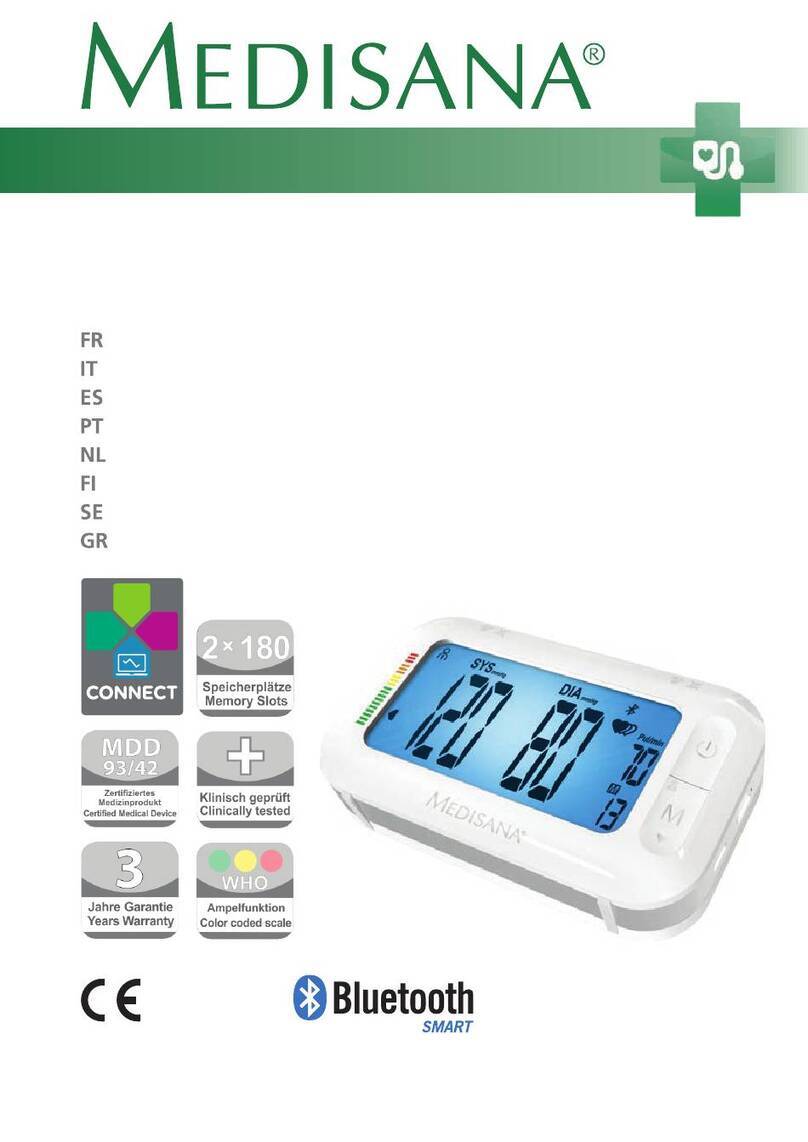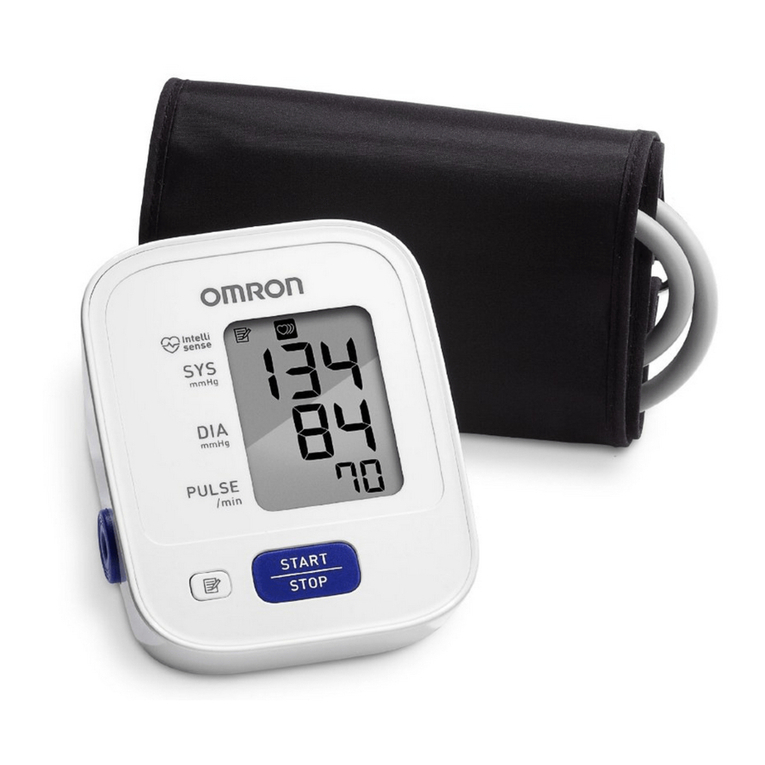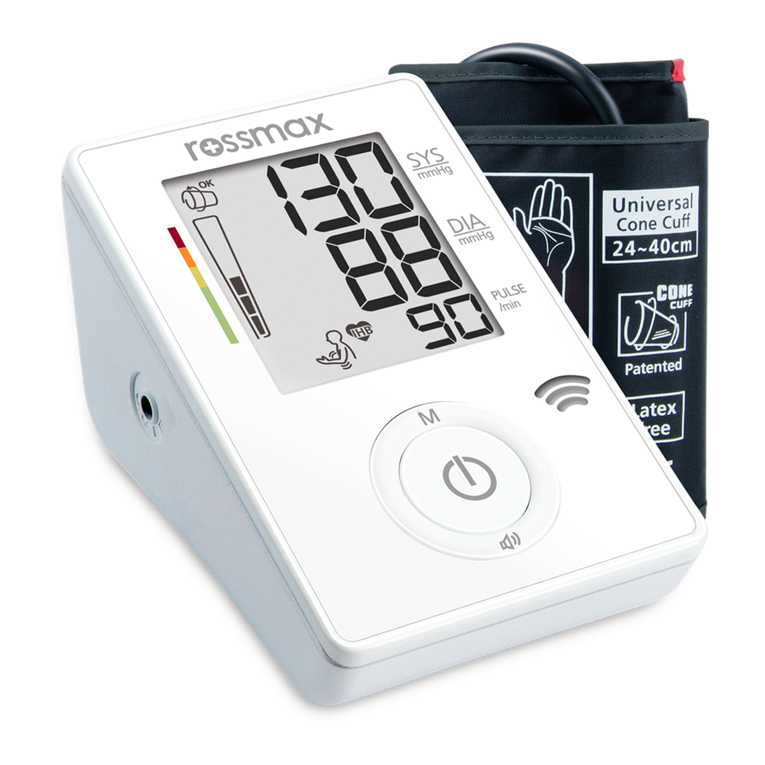Nissei DS-500 User manual

M1 BUTTON
M2 BUTTON
POWER BUTTON
TUBE PLUG
D RING
AIR TUBE
4 AA BATTERIES INSTRUCTIONS
CUFF
MAIN UNIT
AIR CONNECTOR
INDICATIONS FOR USE
e DS-500 system is intended for the non-invasive measurement of systolic
and diastolic blood pressure and determination of pulse rate in adults, i.e., age
12 and above; this unit is not designed for neonatal use. Also, an inaccurate
reading may result if this instrument is used on a child's arm. Consult your
physician if you wish to take a child's blood pressure. e product is
recommended for use by patients with labile blood pressure or known
hypertension in a home care environment as an adjunct to medical
management. e cu will accommodate an upper arm circumference range of
approximately 22 to 32 centimeters. Pressure is measured over a range of 0 to
300 mmHg and pulse rate over a range of 40 to 160 beats/minute.
METHOD OF MEASUREMENT
is product employs the oscillometric method for measurement of blood
pressure and pulse rate. e cu is connected to the main unit and wrapped
around the arm. Circuits within the cu sense the small oscillations in pressure
against the cu produced by the expansion and contraction of the arteries in
the arm in response to each heart beat. e amplitude of each pressure waves is
measured, converted to millimeters of mercury, and displayed on the LCD as a
digital value. If the pulse rhythm detected during measurment was irregular,
irregular pulse rate rhythm indication be displayed. A memory circuit stores
the 30 most recent measurement results with date and time for comparison
and computes the average value of stored data.
PARTS NAMES AND PRODUCT COMPONENTS
PRODUCT SPECIFICATIONS
Model : DS-500
Operating Principle : Oscillometric method
Indicator : 13 digits liquid crystal display
Pressure Indicating Range : 0 to 300 mmHg (Cu pressure)
Measuring Range : 50 to 250 mmHg (systolic)
40 to 140 mmHg (diastolic)
40 to 160 bpm (pulse rate)
Accuracy : ±3 mmHg (Cu pressure)
±5% of reading (pulse rate)
Ination : Automatic ination
Deation : Automatic (electric control valve)
Exhaust : Automatic exhaust valve
Power Supply : 4 pcs. 1.5 volt "AA" (LR6) type batteries
Power Consumption : 4W (max.)
Memory : 30 measurements x 2 and averages
Operating Environment : +10˚C to +40˚C, 85% relative humidity or below
Storage Environment : -5˚C to +50˚C, 85% relative humidity or below
Cu : Coverage arm circumference ; 22 to 32cm
Main Unit : Weight ; Approx. 255g (without batteries)
Size ; 152 x 100 x 60 mm (W x D x H)
Key to symbols : Type BF equipment
: Important ; Read operating instructions
is device complies with EMC (IEC60601-1-2), EN1060-1 and EN1060-3.
Specications are subject to change without notice due to improvements in performance.
CARE AND MAINTENANCE
Use only a so, dry cloth to clean the unit. Do not use gasoline, paint thinner,
or other strong solvents on the unit. Since the cu may absorb perspiration
and other uids, inspect it for stain and discoloration aer each use. When
cleaning the cu, do not machine wash or scrub it. Use a synthetic detergent
and gently rub the surface. Air dry thoroughly. Make sure uid never gets in
AIR HOSE.
When storing the unit, do not place heavy objects on it and do not coil AIR
HOSE too tightly. When the unit has been stored at a temperature below the
freezing point, keep it for at least 1 hour in a warm place before using. Remove
the batteries if the instrument is to be stored for an extended period of time.
Keep the batteries out of reach of children.
We suggest that you have your blood pressure monitor checked every 2 years.
is operation may only be performed by the manufacturer or by rms
authorized by the manufacturer.
Do not use this instrument without consultation with your doctor
if you are under dialysis therapy or on anticoagulants,
antiplatelets or steroids. Use of this instrument under such
conditions could cause internal bleeding.
For specic information on your blood pressure, contact your
physician. Never make any judgment on your own regarding
measurement results.
The material used for the cu bladder is natural rubber latex and it
could cause allergic reactions.
Do not use cus other than the original cu included with this
product.
To avoid any possibility of accidental strangulation, keep this unit
away from children and do not drape AIR TUBE around your
neck.
Use of this device in areas near portable phones, microwave ovens
or other devices with strong electromagnetic eld may cause
malfunctions.
The system may fail to yield specied measurement accuracy if
operated or stored in temperature or humidity conditions outside
the limits stated in the specications section of this manual.
Because the unit includes precision parts, care should be taken to
avoid extreme temperature variations, humidity, shock, dust, and
direct sunlight. Do not drop or strike the unit. Make sure not to
expose the unit to moisture. This unit is not water resistant.
Do not disassemble or modify the unit.
Do not inate the cu when it is not wrapped around your arm.
BASIC PRODUCT INFORMATION
INSTRUCTIONS ENGLISH
DIGITAL BLOOD PRESSURE MONITOR
DS-500
is manual is intended to assist the user in the safe and ecient operation of
Digital Blood Pressure Monitor DS-500. e product must be used in
accordance with the procedures contained in this manual and must not be
used for purposes other than those described herein. It is important to read
and understand the entire manual. In particular, please read carefully and
become familiar with the section entitled “TIPS ON TAKING YOUR BLOOD
PRESSURE”.
PRECAUTIONS FOR USE
...................1
BASIC PRODUCT INFORMATION
.............1
INSTALLING BATTERIES AND SETTING THE CLOCK
... 2
TIPS ON TAKING YOUR BLOOD PRESSURE
.....2
CORRECT MEASURING POSTURE
............2
WRAPPING THE CUFF
....................3
MEASUREMENT PROCEDURES
..............3
MEMORY FUNCTION
.....................4
ERROR DISPLAYS AND TROUBLESHOOTING
....4
TECHNICAL DESCRIPTION
.................4
WARRANTY
is equipment is guaranteed for the period of 2 years aer the date of purchase against
manufacturing defects when returned along with the proof of date of purchase to the
dealer from whom the purchase was made. During this period, the unit will be repaired or
replaced free of charge if the failure is attributable to faulty design or manufacture. is
warranty does not cover damage or malfunctions caused by improper handling or use
contrary to the instructions in this manual. Please contact your dealer for additional
warranty provisions which may remain eective aer the manufacturer's warranty period
has expired.
A116558-1-D
PRECAUTIONS FOR USE
CARRYING BAG
Manufacturer: NIHON SEIMITSU SOKKI CO., LTD. 2508-13 Nakago Shibukawa Gunma 377-0293 Japan
EC-Representative: Nissei Healthcare (UK)LTD. Heneld, BN5 9SJ UK
web site http://www.nisseihealthcare.com

INSTALLING BATTERIES AND SETTING THE CLOCK
1
2
CORRECT MEASURING POSTURE
Sit at the table and let the table support your arm as you take the blood pressure
measurement.
Make sure that the measurement location on the upper arm is at approximately
the same height as the heart, and that the forearm is extended naturally on the
table and does not move.
You may lie on your back and take the measurement. Look at the ceiling, stay calm, and do not
move your neck or body during the measurement. Again, make sure that the measurement
location on the arm is at approximately the same height as the heart.
Measured data may vary slightly depending on the posture during
measurement.
If the cu is lower (higher) than the heart, the measured reading tends to
become larger (smaller).
DIA
mmHg
(severe)
(moderate)
(mild)
High Normal
Normal
100
~
109
110
~
90
~
99
85
~
89
80
~
84
~
80
180~
160~179
140~159
130~139
120~129
~120
SYS
Optimal
Hypertension
20
40
60
80
100
120
140
160
180
200
12 13 14 15 16 17 18 19 20 21 22 23 24 1 2 3 4 5 6 7 8 9 10 11
Blood pressure (mmHg)
Systolic
Diastolic
Time
BATTERY
REPLACEMENT
INDICATION
Replace all the
batteries when the
battery replacement
indication appears on
the display or nothing
is displayed.
e enclosed batteries are
for monitoring, and their
life may be shorter than
that of commercial
batteries.
e used electrical and
electronic products are
not household waste.
Follow your national/
local recycling rules to
dispose of them
properly. In the EU
countries, please refer
to waste management
symbol(s) marked on
the package or the
instrument.
1. Open the battery compartment cover.
2. Install four “AA” (LR6) type batteries into the compartment.
Make sure that the polarities correspond to the (+) and (–) marks inside the battery compartment. e
batteries can be easily installed by pressing their (–) side against the spring.
Do not use rechargeable batteries.
3. Close the battery compartment cover.
Do not force the battery cover into position.
4. Year ashes on the display.
Clock can be set only aer the batteries are reinstalled. Adjust the clock so that measurement results are
stored with correct date and time.
Use M1 BUTTON to increase the ashing year and M2 BUTTON to decrease the year.
Press POWER BUTTON to conrm and move to next step.
5. Month ashes. Adjust the month with M1 BUTTON and/or M2 BUTTON, press POWER
BUTTON to conrm.
6. Day ashes. Adjust the day with M1 BUTTON and/or M2 BUTTON, press POWER
BUTTON to conrm.
7. Hour ashes. Adjust the hour with M1 BUTTON and/or M2 BUTTON, press POWER
BUTTON to conrm.
e clock is in 24 hour mode.
8. Minute ashes. Adjust the minute with M1 BUTTON and/or M2 BUTTON, press
POWER BUTTON to conrm.
Clock is set and the unit is turned o.
e clock is displayed while the unit is turned o.
TIPS ON TAKING YOUR BLOOD PRESSURE
Blood pressure is a measurement of the force exerted by the heart in pumping the
blood through the arteries and the resistance by the veins in this ow.
Blood pressure varies all the time, inuenced by mental and physical
factors and is never constant.
In general, blood pressure is highest during the working hours and gradually
decreases during the aernoon and evening hours. It is low during sleep and
increases at a relatively fast rate aer arising from bed.
Causes for Changes in Blood Pressure
• Body movement • Conversation • Mental Tension
• Emotions • Eating • Drinking Alcohol
• Smoking • Recent Urination or Bowel Movement
• Temperature • Changes in the surroundings such as movement
or noise, etc.
Blood pressure measured at home tends to be lower than when
measured in a hospital, clinic or doctor's oce.
is is because you are tense at the hospital and relaxed at home. It is important
to know your stable normal blood pressure at home.
Let a qualied physician interpret your blood pressure readings.
Depending on your age, weight and general condition, blood pressure can be
slightly dierent. Consult with your doctor on determining what blood pressure
is normal for you.
Before taking blood pressure,
rest for approximately ve
minutes and take your blood
pressure while relaxed in a
quiet environment.
Measure blood pressure using
the correct posture and do not
move or speak during
measurement.
Avoid exercise, eating,
drinking alcohol, smoking
and other activities that aect
your blood pressure right
before a measurement.
Take your blood pressure at
the same time every day.
The ambient temperature
should be approximately 20˚C
when you take your blood
pressure.
Blood pressure classication – WHO (1999)
Blood pressure changes shown below.
Upper arm blood pressure data
page2

WRAPPING THE CUFF
1. Place the cu on your left arm with the
air hose positioned toward your hand.
2. Wrap the cu around your arm with the
edge of the cu approximately 2~3 cm
above the elbow. AIR TUBE should be on
the palm side of the arm.
3. Press the surface of the cu to make
sure that the hook & loop fastens
securely.
When wrapping the cu, wrap it loosely
enough around the arm so that two
ngers can be placed between the cu
and the arm. If the cu is wrapped
more tightly or loosely than this,
inaccurate blood pressure readings may
result.
If you are wearing a shirt that might
restrict circulation in your upper arm
or you roll your sleeve up over the
upper arm, the blood ow will be
restricted, preventing accurate
measurement.
dfhfgjtkdfghhg!
..............
sfhdfrejrgyk;
MEASUREMENT PROCEDURES
Insert TUBE PLUG into AIR
CONNECTOR.
Press POWER BUTTON.
Deation mark ashes.
e cu is automatically inated to the
applied pressure.
Pressure (displayed value) starts to
decrease and pulse is indicated by heart
mark.
When the measurement is complete, air
is automatically released from the cu.
Blood pressures and pulse rate are
displayed.
Heart mark ashes when pulse
rhythm detected during
measurement was irregular.
Press either one of memory
buttons, M1 or M2, and the result
is stored in the selected bank.
e selected memory bank number is
shown on the display. e result is
stored in the bank selected when the
unit is turned o. Irregular pulse
rhythm indication will not be stored,
only blood pressure and pulse rate are
stored. When a measurement resulted
in an error, it will not be stored.
Press POWER BUTTON to turn o
the power.
If you forget to turn o the unit, it will
automatically turn o aer 3 minutes.
Take deep breaths and relax.
Do not move, chat or strain
your arm or hand during
measurement.
To stop measurement
Press POWER BUTTON and ination stops, air is
exhausted, and monitor turns o.
AUTOMATIC REPRESSURIZATION
If the pressure applied is judged insucient in the early phase
of measurement or if movement of the hand or wrist occurs
during measurement, the unit will inate again to a level
about 40 mmHg higher. Automatic Repressurization is
repeated until a measurement is made. However, this does not
indicate a problem.
To manually control pressurization, hold down POWER
BUTTON immediately aer the start of ination and release
it when the pressure reaches the level 50 mmHg higher than
the expected maximum systolic pressure. If the pressure value
has exceeded 180 mmHg, the ination will stop when the key is
released. Pressure can be increased to approximately 300 mmHg.
IRREGULAR
PULSE
RHYTHM
INDICATION
A ashing heart mark in
the measurement result
display indicates irregular
pulse rhythm.
Irregular pulse rhythm can be a result of body movement
during measurement or arrhythmias. Although continuous
appearance of the indication under quiet measurements may
suggest arrhythmias, do not make any judgment on your
own before consulting with your doctor.
Do not execute repeated measurements for
congestion of blood could result in false
measurement. Let your arm rest for at least 5
minutes.
DEFLATION
MARK
INFLATION
MARK
PULSE RATE
MARK
SYS: SYSTOLIC
mmHg
DIA: DIASTOLIC
mmHg
MEMORY BANK
NUMBER
PUL: PULSE RATE
/min
2~3cm
1 2 3
An example of irregular pulse
ryhthm compared to regular
pulse rhythm
regular pulse rhythm
IRREGULAR PULSE
RHYTHM
INDICATION
page3

m
o
r
n
i
n
g
e
v
e
n
i
n
g
30 30
MEMORY FUNCTION
Measured result is stored in either M1 or M2. Each of two memory banks can hold up to 30 results and their average. When the number of
measurements exceeds 30, the oldest data will be deleted to record new data. You may decide which bank to store your measurement results to
avoid data mixture with someone else's, or may use two banks to save data measured in the morning and evening separately.
RECALLING STORED DATA
Press POWER BUTTON once while measurement result is being displayed aer a measurement. DELETING STORED DATA
Show the individual result to be erased or
the average of a memory bank to clear all
the memory bank data.
Press and hold down either one of memory
buttons: M1 button to erase specied data
in memory bank M1, and M2 button to
erase specied data in memory bank M2.
e displayed data starts ashing.
Hold down the button until nothing but the
memory bank number is displayed.
Press memory M1 BUTTON or memory
M2 BUTTON to see stored data.
The average of the stored result in the
selected bank is displayed.
e latest result stored is displayed when there is
only a single result and the clock display remains
when there are no results stored.
e memory data is displayed for approximately 30
seconds. Approximately 30 seconds aer memory
button is released, the apparatus will turn o.
Press memory button to move to next data.
e indication at the top of the display alternately
changes from memory data number to date and to
time.
e memory data number 1 is the latest among the
stored data in the selected memory bank.
Every depression of memory button
switches among the memory data.
As memory button is pressed, the memory data
number increases; the bigger the number, the older
the result.
NUMBER OF
STORED DATA
: average
: latest data
MEMORY
DATA
NUMBER
DATE day/month
TIME
ERROR SYMBOL /
SYMPTOM CAUSE / CHECK POINT CAUSE / CHECK POINTREMEDY ERROR SYMBOL /
SYMPTOM REMEDY
ERROR DISPLAYS AND TROUBLESHOOTING
TECHNICAL DESCRIPTION
Do not move during measurement.
Remain still and quiet during
measurement.
Reinsert TUBE PLUG and make
sure that it is securely inserted.
Properly apply the cu.
Remain still and quiet during
measurement.
Replace all batteries with new ones.
Reinsert the batteries in the
correct position.
Clean with a dry cloth.
Replace all batteries with new
ones.
OVER-PRESSURIZATION;
e cu was inated to the maximum
pressure because of movement of body
etc.
MEASUREMENT ERROR;
Measurement could not be made
because of moving or talking during
measurement.
INFLATION ERROR;
TUBE PLUG is not correctly inserted.
e cu is not properly applied.
DEFLATION ERROR;
Measurement could not be made
because of moving or talking during
measurement.
NO POWER;
Batteries are exhausted.
Have the batteries polarities been
positioned incorrectly?
Are the battery terminals clean?
LOW BATTERY;
Battery is weak.
Measurement is
interrupted once
and cu is deated
and inated again.
Cannot complete
the measurement.
Blood pressure is
dierent each time. e
reading is extremely
low (or high).
Pulse rate is too low
(or too high).
Measurement result
is not stored.
e power is
automatically turned
o.
Press POWER BUTTON to turn
o the power once and press it
again to start a measurement.
is does not indicate a problem.
Do not move during measurement.
Replace all batteries with new ones.
Measure with the correct posture.
See TIPS ON TAKING YOUR
BLOOD PRESSURE.
Remain still during measurement.
Measure again aer resting for
more than 5 minutes.
Conrm the memory bank number.
Make sure desired memory bank
is selected before turning o the
monitor aer a measurement.
is does not indicate a problem.
e instrument automatically turns
o 3 minutes aer a measurement
or 30 seconds aer memory display.
IMPROPER OPERATION;
POWER BUTTON was accidentally
pressed during battery replacement.
When noise is detected or diastolic
blood pressure is low, the cu is
deated and inated again.
Did you move during measurement?
Have the batteries run down?
Are you measuring with correct posture?
Blood pressure readings constantly vary
with time of measurement and nervous
condition.
Did you move during measurement?
Did you take measurement
immediately aer exercise?
Is it the right memory bank?
Did you select correct memory bank
number aer the measurement?
Have you le the instrument untouched
aer the measurement?
If you cannot get correct measurement with the methods above, do not tamper with the internal mechanism. Contact your dealer. If the unit malfunctions, please return it to the dealer or an authorized
service representative for service according to the warranty.
DS-500 complies with the EMC, electromagnetic compatibility, standard, IEC60601-1-2.
Refer to the tables below for specic information regarding compliance to the standard.
DS-500, as a medical electrical equipment, needs special precautions regarding EMC and needs to be installed and put into service according to the EMC information
provided below.
Portable and mobile RF communications equipments can aect the device.
e use of accessories other than those specied in this manual may result in increased emissions or decreased immunity of the device.
DS-500 should not be used adjacent to or stacked with other equipment.
DS-500 is intended for use in the electromagnetic environment specied below. e customer or the user of DS-500 should assure that it is used in such an environment.
Emissions test
RF emissions CISPR 11
RF emissions CISPR 11
Harmonic emissions IEC 61000-3-2
Voltage uctuations/icker emissions IEC 61000-3-3
Compliance
Group 1
Class B
N/A
N/A
Electromagnetic environment - guidance
DS-500 uses RF energy only for its internal function. erefore, its RF emissions are very low
and are not likely to cause any interference in nearby electronic equipment.
DS-500 is suitable for use in all establishments, including domestic establishments and those
directly connected to the public low-voltage power supply network that supplies buildings used
for domestic purposes.
Table 201 - Guidance and manufacturer’s declaration - electromagnetic emissions -
DS-500 is intended for use in the electromagnetic environment specied below. e customer or the user of DS-500 should assure that it is used in such an environment.
NOTE UTis the a.c. mains voltage prior to application of the test level.
Immunity test
Electrostatic discharge (ESD)
IEC 61000-4-2
Electrical fast transient/burst
IEC 61000-4-4
Surge IEC 61000-4-5
Voltage dips, short interruptions
and voltage variations on power
supply input lines IEC 61000-4-11
Power frequency (50/ 60 Hz)
magnetic eld IEC 61000-4-8
IEC 60601 test level
±6 kV contact
±8 kV air
±2 kV for power supply lines
±1 kV for input/output lines
±1 kV dierential mode
±2 kV common mode
<5% UT(>95% dip in UT) for 0,5 cycle
40% UT(60% dip in UT) for 5 cycles
70% UT(30% dip in UT) for 25 cycles
<5% UT(>95% dip in UT) for 5 sec
3 A/m
Compliance level
±6 kV contact
±8 kV air
N/A
N/A
N/A
3 A/m
Electromagnetic environment - guidance
Floors should be wood, concrete or ceramic tile. If oors are covered
with synthetic material, the relative humidity should be at least 30 %.
N/A
N/A
N/A
Power frequency magnetic elds should be at levels characteristic of a
typical location in a typical commercial or hospital environment.
Table 202 - Guidance and manufacturer’s declaration - electromagnetic immunity -
DS-500 is intended for use in the electromagnetic environment specied below. e customer or the user of DS-500 should assure that it is used in such an environment.
NOTE1 At 80 MHz and 800 MHz, the higher frequency range applies.
NOTE2 ese guidelines may not apply in all situations. Electromagnetic propagation is aected by absorption and reection from structures, objects and people.
a Field strength from xed transmitters, such as base stations for radio (cellular/cordless) telephones and land mobile radios, amateur radio, AM and FM radios broadcast
and TV broadcast cannot be predicted theoretically with accuracy. To assess the electromagnetic environment due to xed RF transmitters, an electromagnetic site
survey should be considered. If the measured eld strength in the location in which DS-500 is used exceeds the applicable RF compliance level above, DS-500 should
be observed to verify normal operation. If abnormal performance is observed, additional measures may be necessary, such as reorienting or relocating DS-500.
b Over the frequency range 150 kHz to 80 MHz, eld strengths should be less than [V1] V/m.
Immunity test
Conducted RF IEC 61000-4-6
Radiated RF IEC 61000-4-3
IEC 60601 test level
3 Vrms, 150 kHz to 80 MHz
3 V/m, 80 MHz to 2,5 GHz
Compliance level
N/A
3 V/m
Electromagnetic environment - guidance
Portable and mobile RF communications equipment should be used no closer to any
part of DS-500, including cables, than the recommended separation distance calculated
from the equation applicable to the frequency of the transmitter.
Recommended separation distance
N/A
d=1,2√P, 80 MHz to 800 MHz d=2,3√P, 800 MHz to 2,5 GHz
Where P is the maximum output power rating of the transmitter in watts (W) according to
the transmitter manufacturer and d is the recommended separation distance in metres (m).
Field strengths from xed RF transmitters, as determined by an electromagnetic site
survey,ashould be less than the compliance level in each frequency range.b
Interference may occur in the vicinity of equipment marked with the following symbol:
Table 204 - Guidance and manufacturer’s declaration - electromagnetic immunity -
DS-500 is intended for use in an electromagnetic environment in which radiated RF disturbances are controlled. e customer or the user of DS-500 can help prevent
electromagnetic interference by maintaining a minimum distance between portable and mobile RF communications equipment (transmitters) and DS-500 as
recommended below, according to the maximum output power of the communications equipment.
For transmitters rated at a maximum output power not listed above, the recommended separation distance d in metres (m) can be estimated using the equation
applicable to the frequency of the transmitter, where P is the maximum output power rating of the transmitter in watts (W) according to the transmitter manufacturer.
NOTE1 At 80 MHz and 800 MHz, the separation distance for the higher frequency range applies.
NOTE2 ese guidelines may not apply in all situations. Electromagnetic propagation is aected by absorption and reection from structures, objects and people.
Rated maximum output power of
transmitter W
0,01
0,1
1
10
100
Separation distance according to frequency of transmitter m
150 kHz to 80 MHz N/A
N/A
N/A
N/A
N/A
N/A
80 MHz to 800 MHz d=1,2√P
0,12
0,38
1,2
3,8
12
800 MHz to 2,5 GHz d=2,3√P
0,23
0,73
2,3
7,3
23
Table 206 - Recommended separation distances between portable and mobile RF communications equipment and DS-500 -
page4
Other Nissei Blood Pressure Monitor manuals
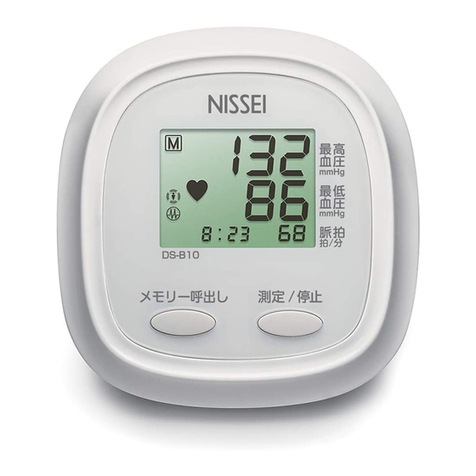
Nissei
Nissei DS-B10 User manual
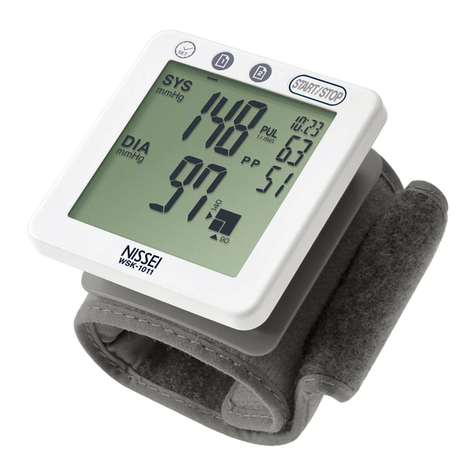
Nissei
Nissei WSK-1011 User manual

Nissei
Nissei DSK-1011 User manual

Nissei
Nissei WS-820 User manual

Nissei
Nissei DSK-1031 User manual
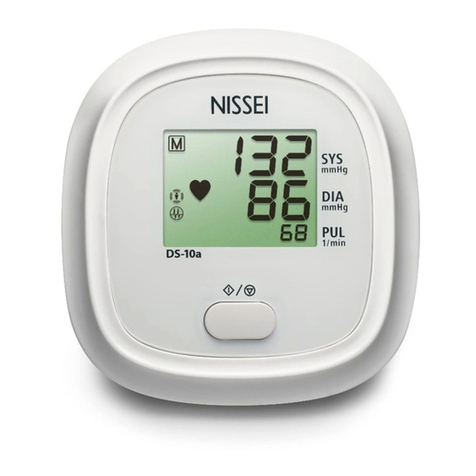
Nissei
Nissei DS-10a User manual
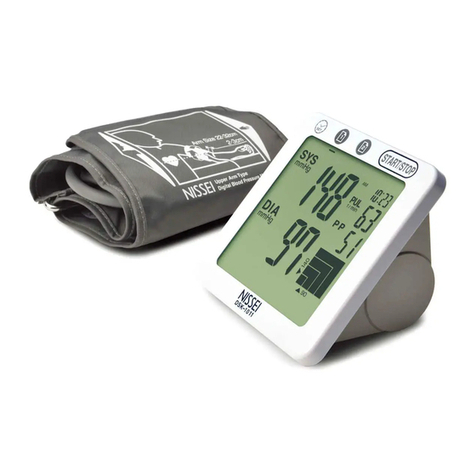
Nissei
Nissei DS-1011 User manual
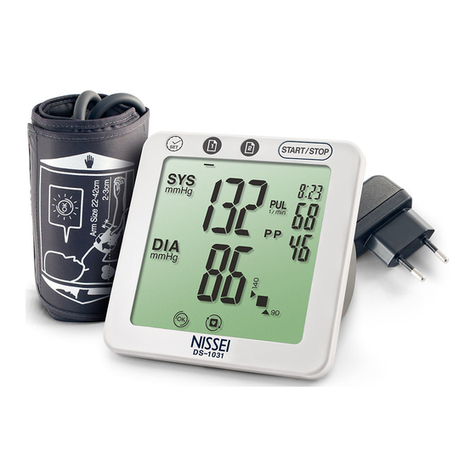
Nissei
Nissei DSK-1031 User manual
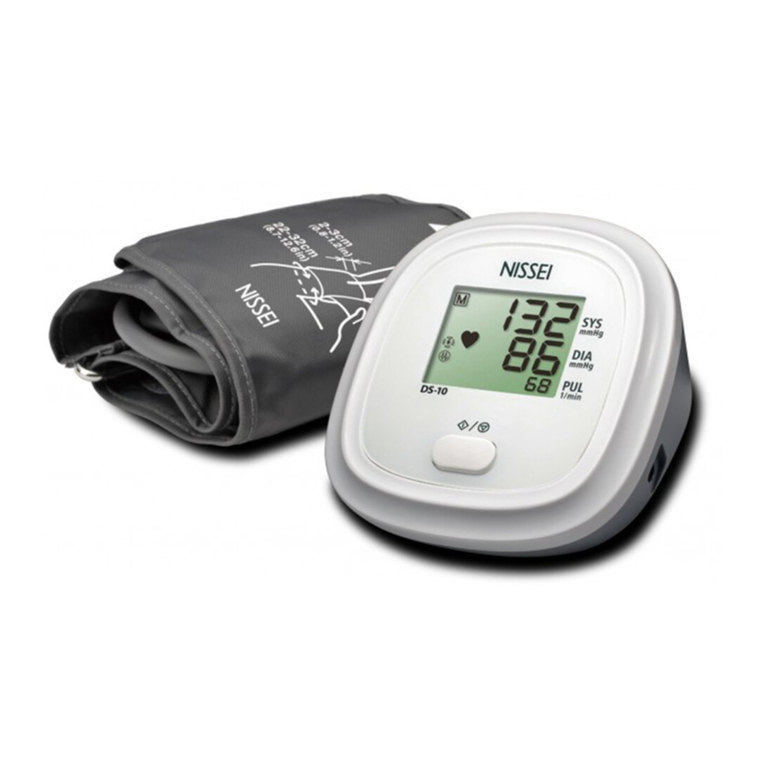
Nissei
Nissei DS-10 User manual
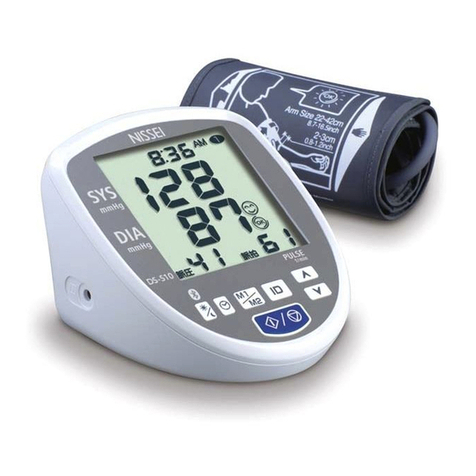
Nissei
Nissei DS-S10 User manual
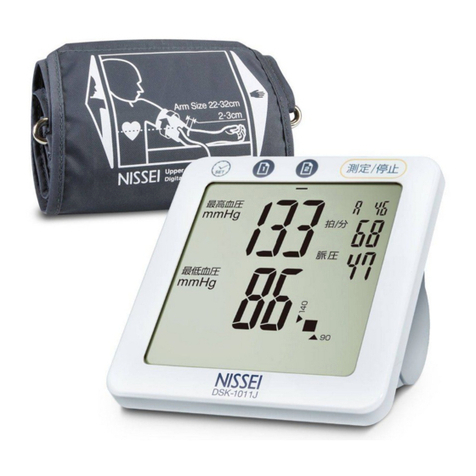
Nissei
Nissei DSK-1011J User manual

Nissei
Nissei WS-1300 User manual

Nissei
Nissei WS-820 User manual

Nissei
Nissei WSK-1011 User manual
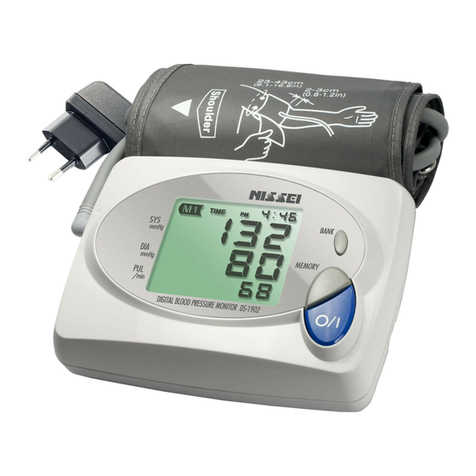
Nissei
Nissei ds-1902 User manual
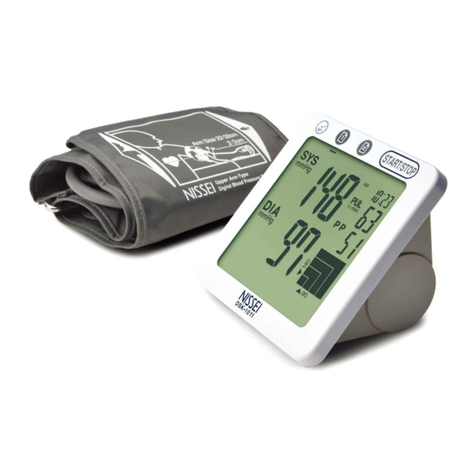
Nissei
Nissei DSK-1011 User manual

Nissei
Nissei DSK-1031 User manual

Nissei
Nissei WS-1011 User manual

Nissei
Nissei DS-137 User manual

Nissei
Nissei DS-400 User manual
